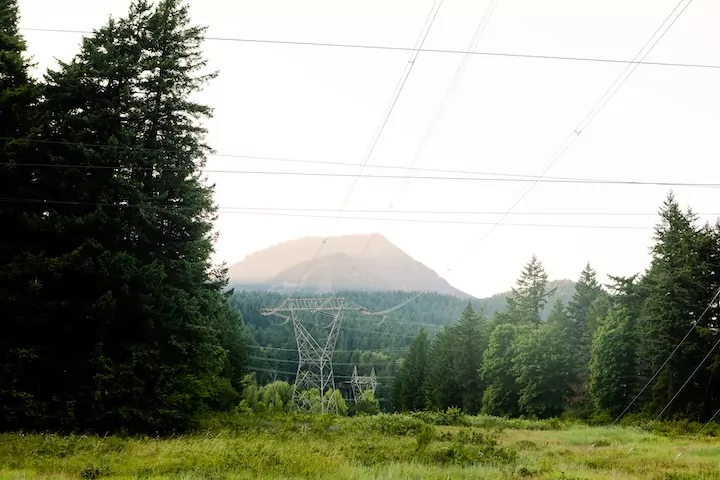
When North America suffered its largest blackout, it cost upwards of USD 6 billion and left 50 million people without power for up to two days. What caused the blackout? Overgrown trees that came into contact with a power line.
Beyond causing blackouts, overgrown vegetation can also cause soil erosion and water quality problems, disrupting both our economy and the environment.
Vegetation management aims to mitigate these risks. But what exactly does vegetation management mean? It involves promoting desirable, stable and low-growing plant communities by using environmentally sound and cost-effective control methods.
In this blog, we’ll explore the importance of vegetation management, its impact on multiple industries, the challenges it presents and how technology can streamline this manual and laborious process.
Why does vegetation management matter?
Vegetation overgrowth affects many industries and requires proactive management.
Power utilities have an infrastructure that spans vast areas, and failures can affect many businesses and consumers. The 2003 blackout mentioned earlier wasn’t an isolated case; in some regions, vegetation causes up to half of the power outages, and in the US, this figure reaches as high as 92%, as reported by the Federal Energy Commission. In addition, poorly managed vegetation poses a fire risk when it contacts transmission lines.
The transportation sector also suffers. High winds or other extreme weather conditions can bring down trees, obstructing railroads or highways. This not only results in revenue loss for rail and toll operations but also incurs significant cleanup costs. When critical infrastructure such as roads and railways shuts down, it disrupts our social and economic networks. For example, blocked roads can prevent people from attending important hospital appointments, meetings or family celebrations, and hinder emergency services such as ambulances and fire trucks from reaching an emergency.
In oil and gas industries, unwanted vegetation around buildings can be a fire hazard, especially in climates prone to wildfires, such as California. Wildfires can cause devastating damage and significant disruption. Day-to-day life can become difficult for the community and local businesses can suffer losses if, for example, they are not accessible. Vegetation management is also crucial in controlling invasive plant species, for example kudzu in the US, which threaten local ecosystems and wildlife habitats. By responsibly managing vegetation on their properties, landowners can support local plants, wildlife and biodiversity.
The challenge of vegetation management
To help keep services running and enable public safety, many organizations allocate budgets for the preventive maintenance of vegetation overgrowth. However, traditional control methods are labor-intensive and don’t adequately respond to the real risks.
Take a rail operator as an example: they might have a vegetation management plan that involves regular removal of tree branches near tracks. At times, the work is done prematurely, leading to unnecessary financial costs. Other times, unexpected rapid vegetation growth due to more frequent extreme weather events might render scheduled inspections too late, complicating the inspection and management of overgrowth.
Across many industries, manual vegetation checks are the norm, but this approach is costly and time-consuming. It might also be difficult for an organization to gain a confident understanding of their vegetation risk.
Organizations affected by vegetation risk need to identify the areas that are most vulnerable or prone to overgrowth. To do so, they need to develop a more efficient and cost-effective vegetation management planning system. Many organizations possess a wealth of potentially useful data in their internal systems, but using this data to inform vegetation management decisions remains a significant challenge.
How can technology support vegetation management?
By implementing the right technology, organizations can transform vegetation management to become less manual and more data driven. For instance, they can employ:
- Satellite and Geiger-mode LiDAR data to monitor vegetation growth around infrastructure and assets, using satellite data to provide comprehensive and up-to-date information.
- Weather data to predict growth patterns and model trees at risk of falling due to high winds or flooding.
- Plant and tree species data to predict the growth rate of vegetation and help plan when to trim.
When vegetation or cloud cover obstructs the view of assets, AI can complete gaps in satellite imagery and even identify tree species, aiding in growth pattern predictions.
With a data-driven strategy, organizations can be more proactive. They can identify overgrowth before it becomes a problem and prioritize vegetation work based on risk. These proactive steps can lead to more efficient use of limited budgets and help organizations reduce the threat to their infrastructure and assets. In highly regulated industries, it also aids in meeting reporting requirements.
AI-driven insights further help identify expansion opportunities. When determining where to build a new bridge or cell phone site, organizations can choose locations where vegetation poses less of a threat and is easier to manage.
Consolidating geospatial data by using tools such as the IBM® Environmental Intelligence Suite enables organizations to manage vegetation more effectively. They can view their assets alongside vegetation data and receive notifications when there’s a risk of encroachment or overgrowth, making it possible to automate the process of manual inspections. This method not only reduces financial costs but also aligns vegetation management with actual risks rather than adhering to a fixed schedule.
Vegetation growth affects many industries. While traditional vegetation management can be labor-intensive and costly, it doesn’t have to be. Using remote sensing data and AI, organizations can predict and avoid real problems and achieve efficient budget utilization. For more on the subject, get the IBM Environmental Intelligence Suite Vegetation Management ebook.
Learn more about vegetation managementWas this article helpful?
YesNo
IBM Newsletters
Get our newsletters and topic updates that deliver the latest thought leadership and insights on emerging trends.Subscribe now More newsletters
- SEO Powered Content & PR Distribution. Get Amplified Today.
- PlatoData.Network Vertical Generative Ai. Empower Yourself. Access Here.
- PlatoAiStream. Web3 Intelligence. Knowledge Amplified. Access Here.
- PlatoESG. Carbon, CleanTech, Energy, Environment, Solar, Waste Management. Access Here.
- PlatoHealth. Biotech and Clinical Trials Intelligence. Access Here.
- Source: https://www.ibm.com/blog/what-is-vegetation-management/
- :has
- :is
- :not
- :where
- $UP
- 01
- 1
- 120
- 2016
- 2019
- 2020
- 28
- 29
- 300
- 31
- 39
- 400
- 50
- 58
- 7
- 8
- 9
- a
- About
- accessible
- According
- Achieve
- Action
- actual
- addition
- addressed
- addressing
- adequately
- adhering
- adjust
- Advertising
- affect
- affected
- AI
- aids
- aims
- Aligns
- All
- allocate
- alongside
- also
- Ambulances
- america
- amp
- an
- analytics
- and
- appointments
- approach
- ARE
- areas
- around
- article
- AS
- Assets
- assumptions
- At
- attending
- AUGUST
- Australian
- author
- automate
- avoid
- back
- based
- BE
- become
- becomes
- before
- begun
- believe
- BEST
- best practices
- between
- Big
- Bill
- Bill Gates
- Billion
- BlackRock
- blocked
- Blog
- Blue
- both
- branches
- BRIDGE
- bring
- budget
- Budgets
- build
- Building
- business
- businesses
- but
- button
- by
- california
- call
- came
- CAN
- cannot
- carbon
- Carbon Reduction
- card
- Cards
- case
- CAT
- Category
- Cause
- caused
- causes
- causing
- celebrations
- cell
- ceo
- challenge
- challenges
- change
- changing
- check
- Checks
- Choose
- circles
- Citizens
- class
- clear
- Climate
- climate action
- Climate change
- Cloud
- color
- commission
- Communities
- community
- compelling
- complete
- comprehensive
- conditions
- confident
- Cons
- Consumers
- contact
- contacts
- Container
- continue
- continuously
- control
- controlling
- Convention
- Core
- Coronavirus
- Corporate
- Cost
- cost-effective
- costly
- Costs
- could
- country
- cover
- COVID-19
- crisis
- critical
- Critical Infrastructure
- crucial
- CSS
- custom
- damage
- data
- data-driven
- Data-driven Strategy
- Date
- day-to-day
- Days
- decision
- decisions
- Default
- definition
- definitions
- deliver
- delivering
- delivery
- described
- description
- determining
- devastating
- develop
- developing
- difficult
- Disruption
- disrupts
- distribution
- do
- does
- Doesn’t
- done
- Dont
- down
- draws
- driven
- due
- Earlier
- Early
- easier
- Economic
- economic impacts
- economy
- Ecosystems
- Edge
- Effective
- effectively
- effects
- efficient
- emergency
- emerging
- enable
- enables
- energy
- Enter
- Environment
- environmental
- environmentally
- EPA
- especially
- established
- estate
- Ether (ETH)
- Even
- events
- Every
- evidence
- evolving
- exactly
- example
- Exit
- expansion
- experts
- Explains
- explore
- extreme
- failures
- Falling
- false
- family
- Federal
- Figure
- finance
- financial
- Fire
- fixed
- follow
- fonts
- For
- forth
- Framework
- frequent
- from
- fundamental
- further
- future
- Gain
- gaps
- GAS
- Gates
- generator
- get
- Global
- global crisis
- Grid
- Growth
- guidelines
- Half
- Have
- Heading
- heavily
- height
- help
- helpful
- High
- highly
- highways
- hinder
- his
- history
- Hospital
- How
- However
- HTTPS
- human
- i
- IBM
- ICO
- ICON
- identify
- if
- image
- Impact
- Impacts
- implementing
- importance
- important
- in
- index
- individual
- industries
- influence
- inform
- information
- Infrastructure
- ingrained
- insights
- instance
- Intelligence
- internal
- intimidating
- into
- invasive
- investment
- Investors
- involves
- isolated
- IT
- ITS
- jpg
- Keep
- Know
- landowners
- large
- Larry Fink
- Late
- latest
- lead
- leaders
- Leadership
- leading
- LEARN
- left
- less
- lidar
- Life
- like
- Limited
- Line
- lines
- local
- local businesses
- locale
- locations
- long-term
- loss
- losses
- maintenance
- Making
- manage
- managed
- management
- managing
- manual
- many
- Market
- Matter
- max-width
- mean
- meeting
- meetings
- mentioned
- method
- methods
- might
- million
- min
- minimum
- minutes
- Mishra
- Mitigate
- Mobile
- model
- Modern
- Monitor
- more
- more efficient
- most
- much
- multiple
- must
- National
- Navigate
- Navigation
- Near
- Need
- networks
- New
- New York
- New York Times
- Newsletters
- North
- north america
- nothing
- notifications
- November
- now
- obvious
- october
- of
- off
- Oil
- Oil and Gas
- on
- ONE
- only
- Operations
- operator
- opportunities
- optimized
- Options
- or
- organization
- organizations
- Other
- our
- Outages
- outcomes
- owners
- page
- Parallels
- Pattern
- patterns
- People
- phone
- PHP
- plan
- planning
- plant
- plants
- plato
- Plato Data Intelligence
- PlatoData
- Play
- plugin
- policy
- political
- politics
- poses
- position
- possess
- possible
- Post
- potential
- potentially
- power
- practices
- predict
- predicting
- Predictions
- presents
- prevent
- primary
- Prioritize
- private
- Proactive
- Problem
- problems
- process
- Product
- Production
- promoting
- properties
- provide
- public
- put
- quality
- Rail
- railways
- rapid
- rapidly
- Rate
- rather
- Reaches
- reaching
- Reading
- real
- real estate
- receive
- reduce
- reduces
- reduction
- regions
- regular
- regulated
- regulated industries
- released
- remains
- remote
- removal
- Renewable
- renewable energy
- Reported
- Reporting
- Requirements
- requires
- reshaping
- Respond
- responsibly
- responsive
- Results
- revenue
- right
- Risk
- risks
- roads
- robots
- Role
- running
- Safety
- satellite
- satellite imagery
- scales
- schedule
- scheduled
- scientists
- Screen
- scripts
- sector
- seems
- seo
- September
- Services
- set
- Shuts
- significant
- site
- small
- So
- Social
- soil
- Solutions
- some
- Sound
- Sources
- spans
- Spending
- Sponsored
- squares
- stable
- standards
- start
- stepping
- Steps
- Still
- Strategy
- streamline
- subject
- subscribe
- such
- Suffers
- suite
- support
- sustainable
- SVG
- system
- Systems
- Technology
- tertiary
- than
- thanks
- that
- The
- The New York Times
- the world
- their
- theme
- These
- they
- this
- those
- though?
- thought
- thought leadership
- threat
- threaten
- threats
- time
- time-consuming
- times
- Title
- to
- too
- tools
- top
- topic
- tracks
- traditional
- Transform
- transition
- transitions
- transportation
- tree
- Trees
- Trends
- Trucks
- two
- type
- understanding
- Unexpected
- United
- unwanted
- up-to-date
- Updates
- upwards
- urgency
- urgent
- URL
- us
- USD
- use
- useful
- using
- utilities
- variety
- Vast
- View
- Vulnerable
- W
- was
- Water
- we
- Wealth
- Weather
- wellbeing
- What
- What is
- when
- which
- while
- Wildlife
- will
- winds
- with
- without
- WordPress
- Work
- world
- worse
- written
- york
- Your
- zephyrnet














